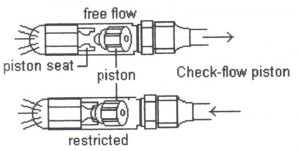Piston vs. TXV Metering Devices
The piston (fixed orifice) and TXV (thermostatic expansion valve) are the two most common metering devices in use today, with some modern systems utilizing an electronically-controlled metering device called an EEV (electronic expansion valve). It should be noted that there are other types of fixed orifice metering devices like capillary tubes, but their use is not common on most modern A/C systems. (However, you will see them in refrigeration.)
While the compressor creates the pressure differential to get the refrigerant moving by decreasing the pressure on the suction and increasing the pressure on the discharge side, the purpose of the metering device is to create a pressure drop between the liquid line and the evaporator coil or expansion line (the line between the metering device and the evaporator when there is one). When the high-pressure liquid refrigerant is fed into the metering device on the inlet, the refrigerant flows out the other side, and the immediate pressure drop results in an expansion of a percentage of the liquid directly to vapor known as “flashing.” The amount of refrigerant that “flashes” depends on the difference in temperature between the liquid entering the metering device and the boiling temperature of the refrigerant in the evaporator. If the difference is greater, more refrigerant will be “flashed” immediately, and if the difference is less, then less refrigerant will be flashed.
Piston
A piston is a replaceable metering device with a fixed “bore.” It is essentially a piece of brass with a hole in the center; the smaller the bore, the less refrigerant flows through the piston and vice versa. The advantage of a piston is that it is simple and can still be removed. You can also change the bore size and cleaned it if need be.

Some piston systems also allow reverse refrigerant flow, as shown in the diagram above. When the reversing valve is energized (cool mode) in a heat pump system, the unit will run in cool mode, and the refrigerant will follow the path indicated on the bottom. This process seats the piston so that refrigerant must pass through the orifice. With the reversing valve de-energized, the flow reverses. That unseats the piston and allows the free flow of refrigerant. In this case, there is a metering device in the condensing unit (outside unit) that meters the flow of refrigerant in heat mode, and there is one inside that meters in cooling mode.

TXV
The TXV can vary the amount of refrigerant flow through the evaporator by opening and closing in response to evaporator heat load. Compared to a fixed orifice, a TXV operates more efficiently in varying environmental conditions (theoretically, at least).
To operate, the TXV has a needle and seat that restricts the flow of refrigerant and acts as the orifice. This needle, when opened, allows more refrigerant to flow, and it restricts refrigerant flow when closed. There are three factors that affect refrigerant flow through a TXV. A sensing bulb filled with refrigerant exerts force to open the TXV. Since gas pressure increases with a rise in temperature, the bulb attached to the suction line after the evaporator coil “senses” the temperature of the suction line. If the suction line becomes too warm, the additional pressure created by the heated refrigerant opens the TXV more to allow additional refrigerant flow. A spring inside the bottom of the TXV exerts pressure to close the valve. An external equalizer senses pressure in the suction line after the evaporator, and it also works to close the valve. In essence, the TXV is a constant superheat device; it sets a (relatively) constant superheat at the evaporator outlet by balancing bulb, spring, and equalizer pressures.
The primary method of charging a system changes based on the type of metering device. A piston system uses the superheat method of charging, and a TXV uses the subcooling method of charging.
No matter what primary method of charging you use, it is still important to monitor suction pressure (evap temperature), head pressure (condensing temperature), superheat, subcool, and delta T (or some other method of airflow verification).
While a TXV and a piston function differently, the end result is a pressure drop and boiling refrigerant in the evaporator.
—Bryan







